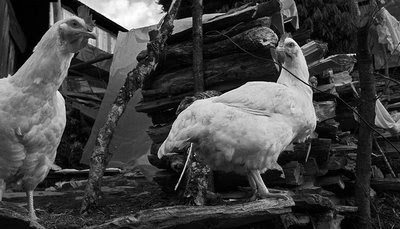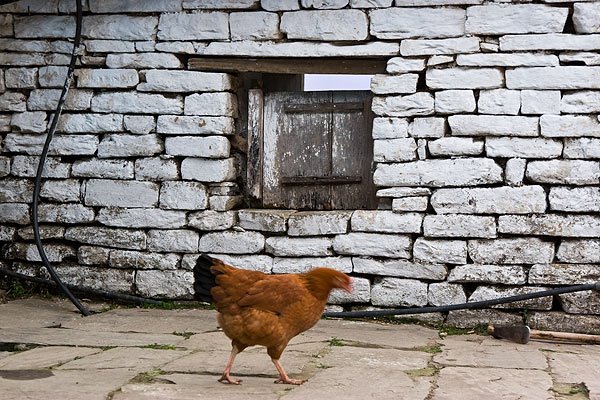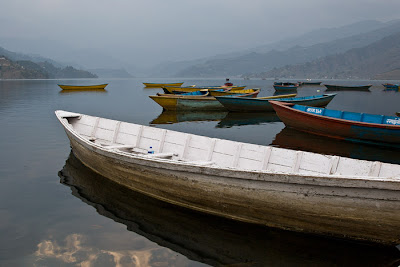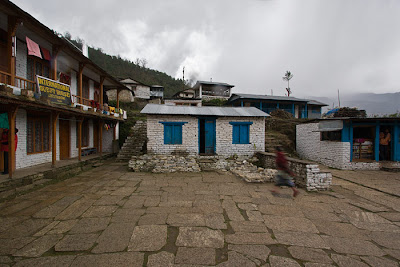
If the Himalaya hotel is, in a sense, abandoned, it will be only for a matter of hours. On the way down we meet several trekkers coming up the the trail. One asks whether we've been to ABC. No, I tell him, bad weather, too much snow, too dangerous because of the avalanches.
“F**k!” he says. A New Zealand accent [1].
We chat briefly, then Kamal and I continue hurrying on down, passing all the trekkers we recognise—the Korean woman with the great, cheerful sense of humour; the young Korean couple; the woman from the US and her guide; the two young Japanese men from Kyoto—and others who must have stayed elsewhere at Himalaya or lower down in Doban or Bamboo. At Sinuwa where we stop for lunch, a French woman and man arrive. I remember meeting them somewhere but can't recall where, and although I don't know it now, I'll meet them again later in Pokhara. They, too, stop for lunch. They're on their way up to Himalaya; they're good company, as is the little boy who lives here. He's about two years old, I'd guess. I'd photographed him the previous day as he practised breaking rocks with a hammer, but today, with the rain falling outside, he collects the squabs from the bench seating, piles them in one corner, climbs on top, and takes great delight in deliberately falling off. If he grows up to be a mountain guide, I don't think I'll hire him.
The rain, which has become heavy and persistent after we left Bamboo, eases as we finish lunch, and we  haven't been gone long before I can fold my umbrella. It's worked far more effectively than a parka, but even so, because we're moving fast and the sun comes out for the last section, I arrive at Chhomrong substantially damp from sweat.
haven't been gone long before I can fold my umbrella. It's worked far more effectively than a parka, but even so, because we're moving fast and the sun comes out for the last section, I arrive at Chhomrong substantially damp from sweat.
In the evening I chat with Zack, a thoughtful, quietly spoken young man from the US Virgin Islands. He and his guide plan to go to Doban the next day and eventually on to ABC. The prospects for getting even as far as Macchapuchare Base Camp appear slight, but Zack's philosophical. As far as possible, he says, he'll be trying to enjoy whatever happens. Just focusing on where he is; appreciating the present. We sit outside while the weather tries to decide what it'll do, and we talk about many things, finding we share similar attitudes to almost everything we discuss, from photography to Buddhism, and tourism to the weirdness of subatomic physics. Conversations like this, and meeting people like Zack, I think, are among the delights of travelling.
Wednesday 14 March 2007
Today will take us from Chhomrong to Tadapani [2]. I've slept, warm and undisturbed, although I woke often. But the waking merely gave me the opportunity to enjoy the knowledge I was warm and undisturbed, and I knew the walk from Chhomrong to Tadapani wouldn't be a big day, so we didn't need an early start. Even the sound of rain on the roof hadn't worried me.
At breakfast the woman from the US joins Zack and me in the dining room. She seems more communicative than she'd been here and at Himalaya. I ask where she's been on her trek.
“Jonsom,” she says.
I ask if she'd flown there to start the trek.
“Oh yeah,” she says. Apparently it's one of the most amazing things she's ever done. “We flew really close to the mountains. My dad's a pilot and he'd have loved it.”
She and her Brahmin guide are walking out today, returning to Pokhara. Zack and his guide are leaving for Doban; Kamal and I heading for Tadapani. The only other trekkers at the guest house are a Korean couple, but I don't know where, or even in which direction, they're going. I say goodbye to Zack and we set off soon after.
“Pani”, in “Tadapani” means water. It's the same word in India.
Here in the dining hall at Tadapani it's warm and noisy, with the largest contingent of trekkers I've encountered in one place so far. Kamal and I have arrived early in the afternoon before the crowds; after showering I settle down in the dining hall to write. A man from Holland reads a book in English about Putin's Russia. Four other trekkers settle in at the other  end of the table, three from Britain, the other apparently of mixed European/American origin. He and one of the Englishmen are experienced travellers. The Englishman tries to bargain with the woman manager over the price of a pot of tea, and then points out with some amusement that the menu clearly states, “Please do not bargain.”
end of the table, three from Britain, the other apparently of mixed European/American origin. He and one of the Englishmen are experienced travellers. The Englishman tries to bargain with the woman manager over the price of a pot of tea, and then points out with some amusement that the menu clearly states, “Please do not bargain.”
Late in the afternoon rain arrives, then a brief shower of hail. The cloud begins to break. Annapurna South gleams, glimpsed through gaps; then it comes more into view behind ragged wisps of cloud. The mountain shines, immense in the evening light, draped with its khata [3] of cloud, framed above by a patchy blue sky and fluttering prayer flags, below by rhododendron forest, a rusted corrugated iron roof, and a faintly smoking chimney. I stay outside in the cold, photographing, changing lenses, watching the changing light, seeing Macchapuchare finally come into view. A long way downriver, over the lower country, brilliant white thundercloud rises in a black sky. Evening develops, and the sky and clouds in the distance begin to take on colour, a faint tinge of orange washing the big mountains around the Sanctuary. As the last sunlight slips up and away, leaving Tadapani in fading light and encroaching cold, I return to the dining hall to try to warm up.
I talk with the young Dutch guy who's been reading the book about Putin. Several other conversations occupy the table—at the far end, a middle aged, long haired man from Holland chats with the older couple from Kenya; a British couple at my end of the table talk with each other, and the experienced travellers talk with their friends and advise another young Englishman about his travels.
“You've got to go to Laos,” one experienced traveller says, and begins listing other places the young man has to go.
The other Englishman wants to know how big the pizzas are. The woman taking his order thinks for a moment.
“Enough for one person,” she says.
After my dahl baht I order a cup of hot chocolate, then return to my room. I sleep comfortably but fitfully, with strange dreams, and wake to a clear sky.
Thursday 15 March 2007
We arrive at Ghorapani soon after 11 a.m., having left Tadapani at 7:30. The plan had been to stop for lunch along the way, but we've made good time.  It's comfortable here; the room's warm, with big windows looking out over the valley. Earlier I could look down to the Kali Gandaki Valley, the gradually fading slopes leading eventually to Dhaulagiri; on in the direction of Jonsom, and Mustang. Mustang, The Forbidden Kingdom. Now, a heavy snow shower begins to ease and the slopes on the far side of the valley reappear, tentatively, as if shy. Here and there, a patch of weak sunlight. A wonderful sense of height and distance, yet here the mountainsides are less steep than some parts of the Ruahine Range—higher, of course, but no more fierce and perhaps less wild. Certainly less remote, because I'm in what amounts to a small town—there's even a police checkpost, as I discovered when I wandered around earlier and came upon the sign and a group of men in their grey and slate-blue camouflage-patterned uniforms.
It's comfortable here; the room's warm, with big windows looking out over the valley. Earlier I could look down to the Kali Gandaki Valley, the gradually fading slopes leading eventually to Dhaulagiri; on in the direction of Jonsom, and Mustang. Mustang, The Forbidden Kingdom. Now, a heavy snow shower begins to ease and the slopes on the far side of the valley reappear, tentatively, as if shy. Here and there, a patch of weak sunlight. A wonderful sense of height and distance, yet here the mountainsides are less steep than some parts of the Ruahine Range—higher, of course, but no more fierce and perhaps less wild. Certainly less remote, because I'm in what amounts to a small town—there's even a police checkpost, as I discovered when I wandered around earlier and came upon the sign and a group of men in their grey and slate-blue camouflage-patterned uniforms.
Three crows glide across an ominous sky, tilting and soaring, banking to turn down towards the rhododendron forest. A fourth crow sweeps in to join them. The dark birds seem like products of the weather, the sky, the immense landscape, rather than separate beings.
The gleam of battered, wet, corrugated iron; the texture of ancient, weathered wood; a pile of angular, broken rocks which might be the remains of a shed or its potential. Everyone seems to hope for clear weather.
“In the morning, maybe it will be clear.”
I try to explain that this weather's great for photographs but they just nod and say nothing. To attempt to explain how a glimpse of a mountain beyond wild cloud might reveal the mountain better than an unimpeded view under a clear sky would be even more futile.
“In the morning, maybe it will be clear, and we will see the mountains.”
But I see them now.
The stove in the middle of the massive dining room throws out enough heat to keep me comfortable even though I'm sitting right next to the window. Kamal understands the implications.
“Ghorapani has many guest houses,” he says. “They have these,” he says, gesturing at the stove. “They use a lot of wood.”
At Tadapani the heating in the dining hall comprised pans of glowing coals placed under the big table, with blankets suspended from the edges of the table. Effective, and far more efficient than here, but still contributing to deforestation. At Chhomrong and Himalaya, the same under-the-table system used a kerosene cooker.
Snow begins to fall again, gradually getting heavier. A crow sits in the naked branches of a small tree about 10 metres away, then drops like a springboard diver. Two white fowls climb a line of stone steps, the snow falling on hens, stone, a blue tarpaulin.
So much depends upon
a blue tarpaulin glazed with snow
beside the white chickens [4]
Friday 16 March 2007
Up at 5 a.m., we're on the way to Poon Hill about a quarter of an hour later. Kamal and I walk steadily, passing almost everyone as we ascend, to arrive as the sky begins to colour in the East. A steady stream of people arrives; scraps of cloud around Macchapuchare turn orange. The cloud over Dhaulagiri turns salmon-pink, then the summit of that great mountain turns the same orange-pink and everything—the early  rise, the knifing, bitterly cold wind, the lack of solitude as people everywhere mill around photographing each other and the sunrise and the mountains—becomes worthwhile. My fingers, exposed by my old, tattered, well-worn, fingerless gloves, begin to turn numb; my face pinches with cold; my nose starts to drip. When the dawn colour fades into the flat light of morning I call it quits and we descend for breakfast.
rise, the knifing, bitterly cold wind, the lack of solitude as people everywhere mill around photographing each other and the sunrise and the mountains—becomes worthwhile. My fingers, exposed by my old, tattered, well-worn, fingerless gloves, begin to turn numb; my face pinches with cold; my nose starts to drip. When the dawn colour fades into the flat light of morning I call it quits and we descend for breakfast.
Then the long walk from Ghorapani to Naya Pul; about 6 hours, give or take half an hour, and including generous stops for lunch and tea. The middle section comprises a long descent, down stone steps that seem never-ending, and I feel a hot spot developing on my left big toe. I've been lucky with the boots, but when we stop for lunch I change back into the running shoes I wore for the first 3 days, apologising to Kamal as I do so, because the boots will weigh his pack down. He grins and seems not to mind. I guess it's a light pack anyway—I've carried all my camera equipment and a few odds and ends, so even with his astonishingly light and small bag added, his load's hardly heavier than my own.
On the descent, a lammergeier soars past, low and close, the best view I've had of these gorgeous birds, huge and powerful. I point it out to Kamal.
“It is looking for chicken,” he says.
Two strong young German men stride past as I'm enjoying lunch, and soon after, a tall, dark haired young woman walks past. I say hello; she replies, then asks if I've seen 2 men go past.
“German guys?”
“Yes!” she says, and sets off after them.
I meet her again at Naya Pul, with the slower of the 2 men. All 3, with 2 guides/porters have just completed the Annapurna Circuit. I'd met the men at Ghorapani yesterday afternoon and laughed with them as they told me how they were running out of money.
“We've spent 40,000 rupees on beer!” one of them said gleefully.
No wonder they were running out of money. They'd claimed to have been still hungover from the previous night, but their wonderful enthusiasm and cheerfulness impressed me nevertheless.
At Naya Pul I negotiate a taxi down to 700 rupees for the 40 km trip back to Pokhara—a much better deal than the 500 I'd paid to get us to Phedi. Our journey among mountains draws to a close; I realise how, the closer we'd got to Naya Pul the more reserved the local people had seemed—slower to smile, more reticent, less willing to let me catch an eye. Commercialism more overt; more stalls lining the path. Perhaps I've been expecting this. At Ghorapani yesterday evening I'd felt strangely low. Quiet, reserved, lacking the energy to be sociable, although  I'd sat around the woodstove with the other trekkers and guides. The feeling wasn't bad, just enough to be noticeable. I remembered Matthiessen's depression towards the end of his journey. He'd attributed it, possibly, to the descent to lower altitudes, but perhaps for him, and for me also, the primary cause might have been the realisation that time among mountains was coming to an end. For me, Ghorapani, although ostensibly still a mountain environment, was like a return to so-called civilisation, with shops and street vendors trying to sell woven belts and hats and necklaces and miniature prayer wheels and other tourist paraphernalia. You could even phone home from Ghorapani. Yet, if I'd bought up large, if I'd spent freely on material things I didn't want, perhaps I'd have been a far better tourist; I'd have contributed more to the economy. This is one of the paradoxes of travelling in places like this—those for whom the larger environment means most—and “stuff” means least—are those who are least suited to supporting those who live there. When it comes to supporting local lives, stuff and the buying of it is more important than empathy for the place and its people.
I'd sat around the woodstove with the other trekkers and guides. The feeling wasn't bad, just enough to be noticeable. I remembered Matthiessen's depression towards the end of his journey. He'd attributed it, possibly, to the descent to lower altitudes, but perhaps for him, and for me also, the primary cause might have been the realisation that time among mountains was coming to an end. For me, Ghorapani, although ostensibly still a mountain environment, was like a return to so-called civilisation, with shops and street vendors trying to sell woven belts and hats and necklaces and miniature prayer wheels and other tourist paraphernalia. You could even phone home from Ghorapani. Yet, if I'd bought up large, if I'd spent freely on material things I didn't want, perhaps I'd have been a far better tourist; I'd have contributed more to the economy. This is one of the paradoxes of travelling in places like this—those for whom the larger environment means most—and “stuff” means least—are those who are least suited to supporting those who live there. When it comes to supporting local lives, stuff and the buying of it is more important than empathy for the place and its people.
...
Strange dreams. I'm entrusted with 2 gorgeous kittens; in another I'm hugged hard by a small woman I seem to have known but can't recognise. There's joy in these dreams. But in another, I'm responsible for a shed full of fowls and I've neglected them; they're dying of starvation, thirst, and disease. A vivid image of one bird breathing heavily and laboriously through a grotesquely swollen face; a bird struggling to live just a little longer. Birds dying—yet in the midst of this suffering, for which I alone am completely responsible, eggs are hatching, chicks are born into this world where there is nothing to eat, no water to drink, and where they will soon die among the squalid straw and dung and diseased corpses of other fowls. The cruelty of my neglect appalls and horrifies me.
I realise I've had this dream before, several times. What does it mean?
What, or who, am I neglecting?
Notes:
1. I met him twice later—in Kathmandu, and at Kathmandu airport on the return to Delhi.
2. Tadapani is pronounced “Tarapani”.
3. Khata are ceremonial scarves.
4. Inspired by William Carlos Williams' famous Red Wheelbarrow.
Photos (click to enlarge them):
1. Forest in rain, near Doban on the return from Himalaya to Chhomrong.
2. Rufous sibia, Heterophasia capistrata, on rhododendron at Chhomrong. The white flecks on its head are pollen.
3. Ridge to Annapurna South, from Tadapani.
4. Evening over the valley of the Kali Gandaki, looking in the direction of Jonsom and Mustang.
5. Pack ponies, Ghorapani.
6. Chooks at Ghorapani. This breaks almost every rule of composition but I still like it.
7. Annapurna South in clearing weather.
Photos and words © 2008 Pete McGregor









